用于热中子屏蔽和结构应用的新型gd掺杂MoAlB陶瓷的微观结构和综合性能
IF 5.6
2区 材料科学
Q1 MATERIALS SCIENCE, CERAMICS
引用次数: 0
摘要
本研究探索了gd掺杂MoAlB陶瓷作为一种具有集成结构和屏蔽能力的多功能材料在先进核能应用中的潜力。合成了三种具有最佳辐射屏蔽性能的GdxMoAlB (x = 0, 0.05, 0.1),研究了Gd浓度对其微观结构、力学性能和抗氧化性能的影响。Gd0.1 MoAlB的热中子线性衰减系数比纯MoAlB高6.47倍。烧结陶瓷主要由Mo(Al,Gd)B固溶体组成,并含有少量的杂质,如Gd6Mo4Al43和GdAl。Gd的掺入提高了MoAlB的力学性能,其中Gd0.1的维氏硬度(10.80±0.46 GPa)和抗压强度(2.31±0.03 GPa)最高,同时塑性也有所提高。然而,过量的Gd添加会导致氧化过程中形成GdAlO3和GdAl3(BO3)4等次级相,从而降低MoAlB的抗氧化性。Gd0.05组合物被认为是最有希望的候选组合物,它结合了改进的力学性能和显著增强的热中子屏蔽,而不影响相稳定性或抗氧化性。本工作为在恶劣环境下研究高性能的先进多功能材料奠定了理论和实验基础。本文章由计算机程序翻译,如有差异,请以英文原文为准。
Microstructure and comprehensive properties of a novel Gd-doped MoAlB ceramic for thermal neutron shielding and structural applications
This study explores the potential of Gd-doped MoAlB ceramics as a promising multifunctional material with integrated structure and shielding capabilities for advanced nuclear energy applications. Three compositions of GdxMoAlB (x = 0, 0.05, 0.1), selected for their optimal radiation shielding properties, were synthesized to investigate the effects of Gd concentration on microstructure, mechanical properties, and oxidation resistance. Gd0.1 MoAlB exhibits a thermal neutron linear attenuation coefficient 6.47 times higher than pure MoAlB. The sintered ceramics are predominantly composed of the Mo(Al,Gd)B solid solution, with small amounts of impurities such as Gd6Mo4Al43 and GdAl. Gd doping enhances the mechanical properties of MoAlB, with Gd0.1 showing the highest Vickers hardness of (10.80 ± 0.46 GPa) and compressive strength (2.31 ± 0.03 GPa), coupled with increased ductility. However, excessive Gd addition results in the formation of secondary phases such as GdAlO3 and GdAl3(BO3)4 during oxidation which compromise the oxidation resistance of MoAlB. Gd0.05 composition is proposed as the most promising candidate, combining improved mechanical properties with significantly enhanced thermal neutron shielding, without compromising phase stability or oxidation resistance. This work lays the theoretical and experimental foundation for the research on advanced multifunctional materials with enhanced performance in harsh environments.
求助全文
通过发布文献求助,成功后即可免费获取论文全文。
去求助
来源期刊

Ceramics International
工程技术-材料科学:硅酸盐
CiteScore
9.40
自引率
15.40%
发文量
4558
审稿时长
25 days
期刊介绍:
Ceramics International covers the science of advanced ceramic materials. The journal encourages contributions that demonstrate how an understanding of the basic chemical and physical phenomena may direct materials design and stimulate ideas for new or improved processing techniques, in order to obtain materials with desired structural features and properties.
Ceramics International covers oxide and non-oxide ceramics, functional glasses, glass ceramics, amorphous inorganic non-metallic materials (and their combinations with metal and organic materials), in the form of particulates, dense or porous bodies, thin/thick films and laminated, graded and composite structures. Process related topics such as ceramic-ceramic joints or joining ceramics with dissimilar materials, as well as surface finishing and conditioning are also covered. Besides traditional processing techniques, manufacturing routes of interest include innovative procedures benefiting from externally applied stresses, electromagnetic fields and energetic beams, as well as top-down and self-assembly nanotechnology approaches. In addition, the journal welcomes submissions on bio-inspired and bio-enabled materials designs, experimentally validated multi scale modelling and simulation for materials design, and the use of the most advanced chemical and physical characterization techniques of structure, properties and behaviour.
Technologically relevant low-dimensional systems are a particular focus of Ceramics International. These include 0, 1 and 2-D nanomaterials (also covering CNTs, graphene and related materials, and diamond-like carbons), their nanocomposites, as well as nano-hybrids and hierarchical multifunctional nanostructures that might integrate molecular, biological and electronic components.
 求助内容:
求助内容: 应助结果提醒方式:
应助结果提醒方式:


